Asphalt pavements generally last anywhere between 10 to 30 years when installed correctly. But rainwater, sunlight, motor oil, and heavy foot/vehicular traffic can drastically cut down your parking lot or driveway's lifespan.
Why is it important to fix damaged asphalt ASAP?
Your driveway or parking lot may not be as expensive as the building you own or manage, but a considerable amount of money was still used to have it built. In this day and age when the price of goods and labor keeps going up, you can't afford to fumble the bag when it comes to business expenses.
That's why we recommend patching damaged asphalt as soon as you spot the need.
Timely asphalt patching doesn't just keep your parking lot or driveway from deteriorating further; fixing it also boosts your property's curb appeal and ensures that you or anyone who uses it won't trip and injure themselves.
What do you use to patch asphalt?
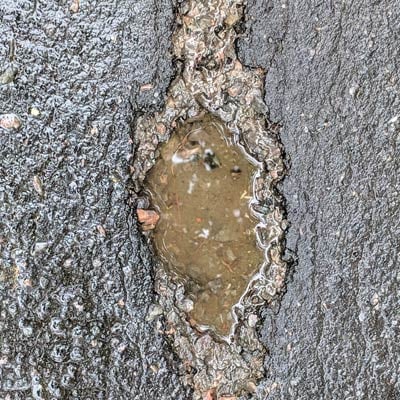
There are different ways to patch asphalt, and the type of product you use depends on the damage you're trying to fix.
Alligator cracks (also known as crocodile cracking), for example, can be patched using a product called Gator Patch.
Potholes and birdbaths, on the other hand, can be repaired with cold mix asphalt (also known as pothole patch) or by adding fresh asphalt millings and using a piece of equipment called an infrared asphalt heater.
Want to learn more about asphalt patching? Here are 7 of the most important tips on how to get it done.
Related: Five Common Pavement Eyesores and How to Fix Them
7 Tips for DIY Asphalt Patching
1. Conduct a thorough inspection of your driveway or parking lot and create a game plan
Before you buy asphalt patching products online or from your local hardware store, make sure that you conduct a detailed inspection of your driveway or parking lot.
A thorough inspection allows you to determine:
- How many cracks or potholes need to be patched and their exact location
- Which asphalt patching product you'll need to purchase
- The amount of product you need for your project
Tip: Create a simple map of your driveway or parking lot (or both), note where the damages are, and list all information relevant to your task, taking photos even if you don't think you'll need them.
An asphalt repair game plan also allows you to implement traffic control (important for commercial property owners). Block the area you're going to fix using some traffic cones and attention ribbon, but ensure that your customers can still use the rest of the parking lot.
2. Use the right asphalt maintenance products
Now that you have a game plan, you can shop asphalt patching products online or in-store. This is a good time to also purchase asphalt cleaning products.
What are the products you're going to need for patching asphalt? Check out the list below:
Asphalt Cleaning Equipment
- A wire street broom or a rotary broom for removing dust, loose asphalt, and moss
- A handheld or walk-behind leaf blower
- A heat lance for killing weeds that grow between the cracks
Asphalt Repair Products
- Gator Patch
- Cold Mix Asphalt Patch
- Asphalt Millings
- Asphalt Rejuvenator
Asphalt Patching Tools
- Asphalt Tamper Tool
- Asphalt Lute or Rake
- Asphalt Roller
When it comes to fixing damaged asphalt, no product is suitable for everything. You need to purchase the right product for the type of damage you are trying to fix or you'll be wasting your time and money.
For example, alligator cracks are best patched with Gator Patch, a mud-like material spread over the cracks using a squeegee.
Don't use liquid or hot pour crack filler to patch multiple cracks — like alligator cracking — as these products simply won't work.
If only patching one or two potholes, you can use cold mix asphalt patch. But if you own a large property and it needs to be maintained frequently, then it's best to use an asphalt infrared heater and asphalt millings instead.
Related: Can Gator Patch Save Your Cracked Asphalt?
3. Proper surface preparation is important
It is tempting to apply some Gator Patch on a cracked section of your parking lot, spreading it immediately to save time. But conducting proper asphalt surface prep is essential to the success of your parking lot patching project.
Your driveway or parking lot might look clean, but take a closer look and you'll see a lot of dust, debris, and moss sitting on the surface. There are also weeds and loose asphalt that you have to remove. If you apply an alligator patch directly onto dirty asphalt, the product simply isn't going to stick and you have to redo it at some point in time in the future.
So how do you conduct proper surface prep?
The answer depends on what kind of asphalt damage you're trying to fix.
For alligator cracking, you're going to need a wire street-broom or a rotary broom to remove dust, leaves, and moss. Clean everything up with a handheld or walk-behind leaf blower to make sure everything's 100% clean.
When everything is clean, you can now apply Gator Patch.
Is prepping a pothole necessary?
The good news is potholes need minimal surface prep. You just need to remove vegetation and loose aggregates to get started. You can clean them by using a shovel, a broom, and a gas blower.
If the pothole has a puddle in it, don't worry. Cold patches are usually water-activated, so it's fine to dump them in a pothole with a bit of puddle in it.
4. Have all your equipment ready before you start patching asphalt
There's nothing more annoying than being ready to patch asphalt only to discover that you don't have your walk-behind wheel blower with you or you don't even own a rake or shovel.
Being in the middle of patching a pothole only to find that you don't have enough Gator Patch or Aquaphalt means you'll have to go back to your garage or storage area to get that one tool you need. Or wait several days for supplies to arrive.
Be more efficient by having everything you need on-site before you start working.
5. Use Gator Patch for alligator cracks
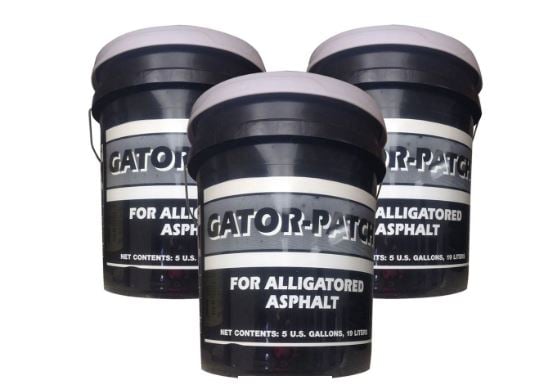 Gator Patch for fixing alligator cracks on asphalt
Gator Patch for fixing alligator cracks on asphalt
Are you dealing with alligator cracks? Then fix it with Gator Patch in a few simple steps!
- To start, create a temporary border around the work area using duct tape.
- Next, apply Gator Patch onto the alligatored asphalt.
- Get your trowel or squeegee and spread the product all over the cracks as evenly as possible. (Make sure to cover the entire alligatored area with Gator Patch.)
Note: Use only what you need to patch the alligatored area to so as not to waste the product. Don't pour the entire content of the bucket if you're only patching a small or midsized area.
- A few passes of the squeegee will do; make sure to keep the edges clean by removing any excess Gator Patch. Don't overwork the product as it will affect the texture!
- Let Gator Patch set into the cracks and dry before applying a second coat
- Remove the duct tape and let the area dry and cure properly before using the parking lot or driveway again.
Watch the video below to learn more about Gator Patch and how it is applied.
Video: How to Repair Alligator Cracks with Gator Patch
6. Limited on time to patch potholes or looking for a cost-effective option? Use cold asphalt patch
Weekends are for your family and your hobbies, and the last thing you want to do is spend the entire Saturday patching potholes. Perhaps you want an asphalt patching product that is affordable and doesn't need a piece of special equipment to apply. Then use cold mix asphalt.
Cold asphalt patch is made up of aggregates and asphalt binders. Apply this product in 4 easy steps:
- Simply pour the contents of the bag into the potholes.
- Start spreading the product in the pothole using a rake, lute, or shovel. Feel free to add some more cold mix asphalt if necessary.
- Now take your watering can or garden hose and gently pour some water into the repaired area.
- Use your tamper to compact the repaired area. You can also use a plate compactor or asphalt roller to make sure that the entire surface is level.
Don't have a tamper or a plate compactor? Just use your car to drive over the repaired area several times until it's compact and even and you're all set.
Related: How to Do a Pavement Assessment
7. Maintaining large parking lots? Then fix those potholes using an infrared asphalt heater
Another way to fix potholes is by using an infrared asphalt heater. This piece of equipment is ideal for property owners or facility managers who must maintain large properties, like an airport, a mall, or a hospital.
To fix a pothole using this method, you need to have the following:
- Asphalt millings
- Mini Infrared Asphalt Heater
- Asphalt Rejuvenator
- Asphalt lute or rake
- Tamper tool or asphalt roller
- Asphalt Hot Box
Pothole Patching Process with Infrared Asphalt Heaters:
- To start, wheel the Mini Infrared Asphalt Heater on top of the pothole or birdbath you're going to repair. Turn the machine on to heat the asphalt underneath and wait several minutes for it to soften.
- Once the asphalt has softened, turn the machine off and wheel it out of the way.
- Take your asphalt lute and with the blunt edge, push the edges of the softened asphalt a couple of inches inward. Flip the lute and use the sharp edge to rework the entire area.
- Shovel some asphalt milling into the pothole and spray it with some asphalt millings rejuvenator. Use a tamping tool, plate compactor, or asphalt roller to compact the area. The repaired section can be used immediately once it is level.
Conclusion:
Now that you know how to patch asphalt, it's time to start practicing and perfecting it.
Where to find the best asphalt patching supplies, tools, and equipment? You can find them all here at the Asphalt Kingdom store. If you need additional help on the right product to purchase or information on the amount of asphalt patching product you should buy, simply give us a call at 1-866-399-5562 or reach out to us via email.
Do you own a golf course or a car dealership? Read our case studies to learn how timely and regular asphalt maintenance can help prolong your pavement asset.


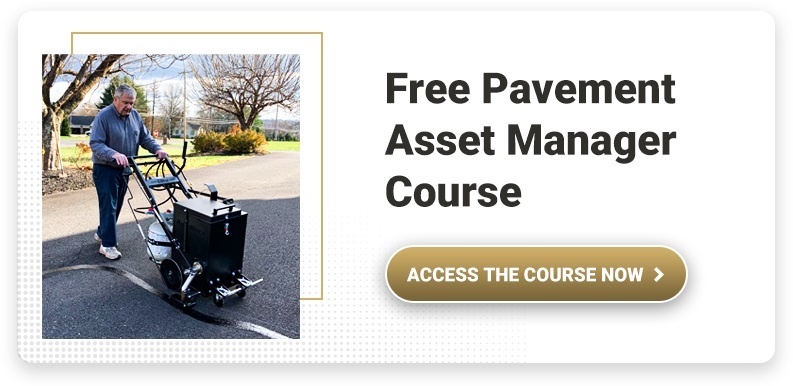

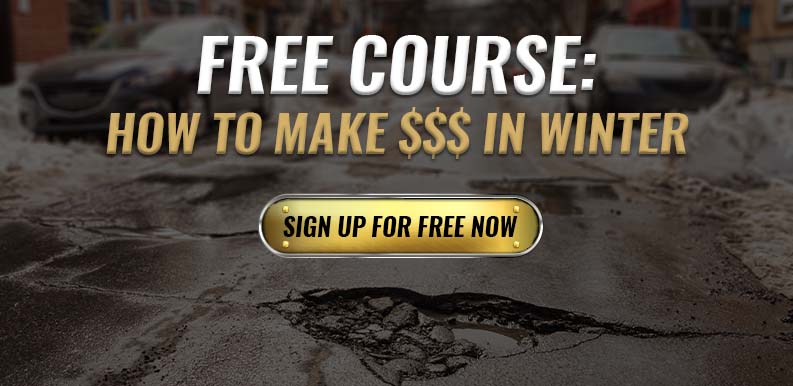
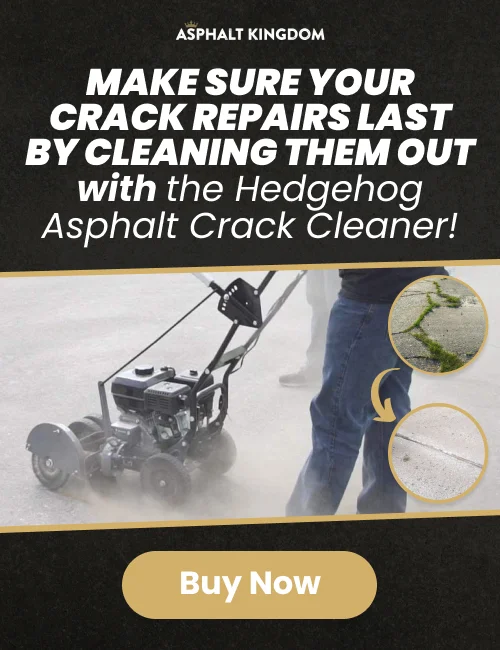




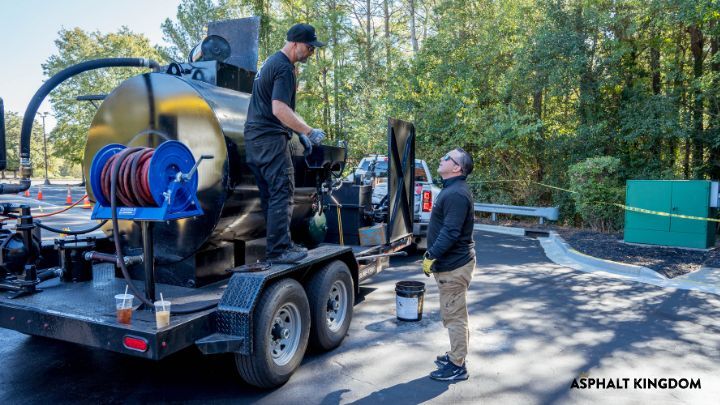
-2.jpg)
-1.jpg)